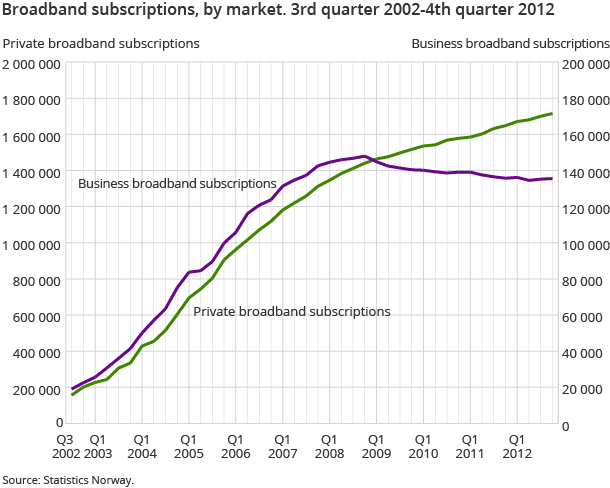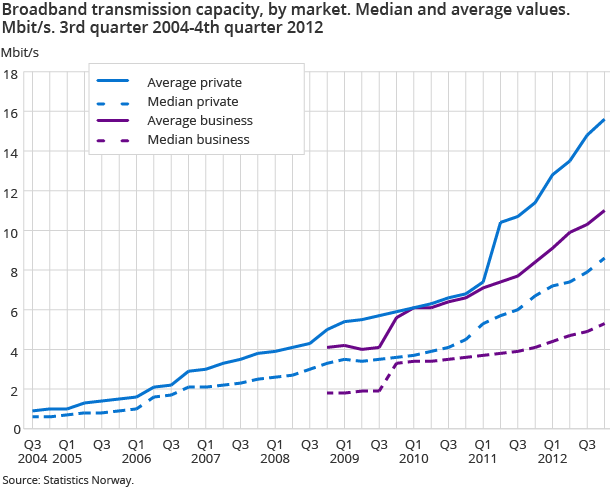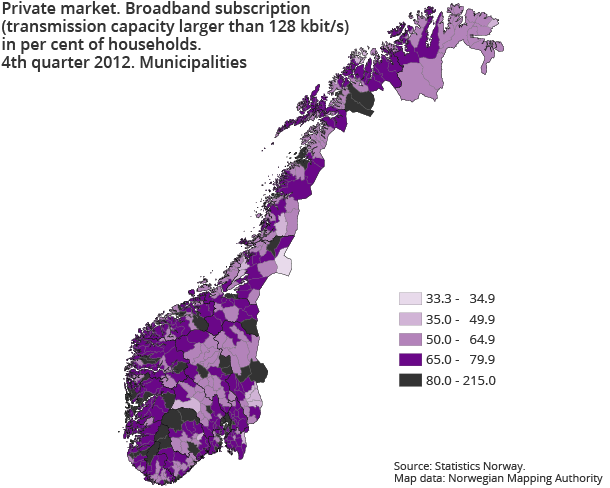Content
Published:
This is an archived release.
Broadband speed increased one third last year
The average capacity of private fixed broadband access increased 37 per cent last year. For business broadband the increase was 31 per cent. The number of fixed broadband connections has increased 4 per cent in the last year.
| 4th quarter 2012 | 3rd quarter 2012 | 4th quarter 2011 | 4th quarter 2011 - 4th quarter 2012 | ||
|---|---|---|---|---|---|
| Change | Change i per cent | ||||
| Fixed broadband | 1 851 606 | 1 836 585 | 1 784 738 | 66 868 | 3.7 |
| Private broadband | |||||
| Private broadband subscriptions | 1 716 000 | 1 701 288 | 1 648 910 | 67 090 | 4.1 |
| Private broadband subscriptions per 100 households | 76.7 | 76.0 | 74.8 | 1.9 | 2.5 |
| Average transmission capacity (Mbit/s) | 15.6 | 14.8 | 11.4 | 4.2 | 36.8 |
| Median transmission capacity (Mbit/s) | 8.6 | 7.9 | 6.7 | 1.9 | 28.4 |
| Business broadband | |||||
| Business broadband subscriptions | 135 606 | 135 297 | 135 828 | -222 | -0.2 |
| Average transmission capacity (Mbit/s) | 11.0 | 10.3 | 8.4 | 2.6 | 31.0 |
| Median transmission capacity (Mbit/s) | 5.3 | 4.9 | 4.1 | 1.2 | 29.3 |
67 000 more private fixed broadband subscriptions in a year
The number of private broadband subscriptions with fixed access in Norway, including Svalbard, was 1 716 000 at the end of the 4th quarter of 2012; an increase of 67 000 subscriptions in the last 12 months. Compared to the previous quarter, this is an increase of 15 000 subscriptions.
The number of business subscriptions is stable at around 136 000.
Steady increase in broadband capacity
The average transmission capacity for fixed private broadband increased to 15.6 from 14.8 Mbit/s in the previous quarter. At the same time, the median value increased to 8.6 Mbit/s compared to 7.9 in the previous quarter. One year ago the average transmission capacity was 11.4 Mbit/s and the median value was 6.7 Mbit/s.
The average transmission capacity for fixed business broadband increased to 11.0 from 10.3 Mbit/s in the previous quarter. At the same time, the median value increased to 5.3Mbit/s compared to 4.9 in the previous quarter.
Private broadband subscriptions with a capacity of more than 8 Mbit/s total 51 per cent; an increase from 49 per cent in the previous quarter. Only 34 per cent of business broadband subscriptions have this capacity; an increase from 32 per cent in the previous quarter.
The broadband penetration rate in private households is 77 per cent, which is an increase from last year’s 75 per cent. The figure for private broadband subscriptions per 100 households varies between 84 per cent in thecountyofOsloand 63 per cent in thecountyofFinnmark.
Not all providers are included Open and readClose
The number of Internet service providers reporting to this survey has been around 200 over the past few years. Market changes have reduced this number to around 170. A few small, but potentially locally important Internet service providers, mostly cable TV providers, may still not be included in the survey. Efforts have been made to include these providers. Some small errors related to the distribution of subscribers between municipalities may occur. This can have major consequences for the figures per household for some municipalities. The number of households for 2012 has been used in these statistics.
The difference between the number of subscribers and the number of householdsOpen and readClose
Individuals and businesses can have several Internet subscriptions and several individuals can use the same subscription. The number of subscriptions is therefore not equivalent to the number of households/businesses with Internet access. A household can for instance get Internet access through an employer, educational institution or by sharing access with other households. The survey ICT usage in households provides more information about households with at least one member under the age of 75 with Internet access.
Contact
-
Statistics Norway's Information Centre
E-mail: informasjon@ssb.no
tel.: (+47) 21 09 46 42



